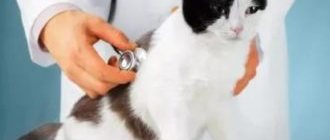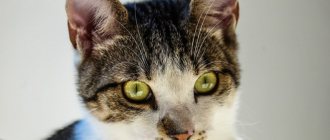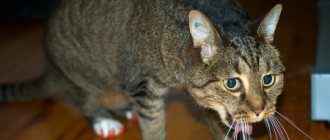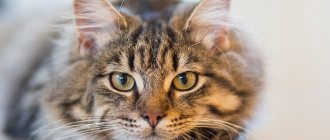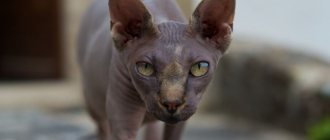Forms of peritonitis
At risk are cats under two years of age and over ten years of age.
Peritonitis is an inflammatory process in the abdominal cavity; based on the etiology and type of course of the inflammatory process, the disease is divided into forms.
Infectious
A type of nonspecific infectious inflammation is formed when pathogenic flora penetrates the peritoneum; the process occurs due to injuries, damage to the digestive organs by bones or other sharp objects.
The provoking factor may be an ulcer or tumor growth in the gastrointestinal tract.
Sometimes dense feces or hair balls, passing through the intestines, damage the mucous membrane and form microcracks, which leads to the development of pathology.
Viral
In cats, viral peritonitis, or FIP, occurs after infection with the relatively harmless strain of RNA virus FECV that causes coronavirus infection.
When the pathogen penetrates the oral cavity, it first multiplies in the epithelial cells of the pharynx, respiratory and intestinal organs.
Peritonitis is fatal in 90% of cases.
In adult animals the disease is usually asymptomatic, in kittens it manifests itself in the form of enteritis, accompanied by vomiting and diarrhea. After recovery, the cat remains a carrier and distributor of the pathogen for up to 3-8 months.
In 10% of cases, the virus mutates, changes into a pathogenic strain of FIPV, infects macrophages - T-cells responsible for immunity, and spreads through the bloodstream throughout the body.
The disease becomes systemic and manifests itself as severe peritonitis. Depending on how the process develops further, three forms of peritonitis are distinguished.
Wet
It is observed in 75% of animals when infected macrophages are massively concentrated around blood vessels, usually under the serous membranes and organ cavities.
Peritonitis is an inflammatory disease of the membrane covering the abdominal organs
This entails an increase in the permeability of their walls, causing the accumulation of protein effusion in the peritoneum, pleural area, and in some animals in the heart sac or scrotum.
Small necrotic or granulomatous nodules form. The condition is dangerous, characterized by an acute or subacute course.
Dry
If the vessels are less exposed to the virus, a condition develops when granulomas form in the body tissues. The disease occurs in a chronic form and is proliferative in nature.
Purulent
Pus in the abdominal cavity is formed during the decomposition of pathological exudate.
Description of the disease
Viral peritonitis in cats develops against the background of a mutation of the coronavirus.
Its exact mechanism is unknown. It is usually triggered by stress. When infected with coronavirus, there are no obvious signs of infection. In some cases, kittens or weakened adults develop intestinal upset.
Infectious peritonitis in cats occurs in two forms:
- Wet (exudate) - viscous, light yellow liquid accumulates in the pleural (chest) or abdominal cavity.
- Dry – internal organs are affected by granulomatous (nodular) pathological changes.
Both forms lead to the death of the animal. The disease most often occurs in kittens and adults under 3 years of age, as well as older cats over 10 years of age. The likelihood of developing viral peritonitis does not depend on the sex of the animal. Outbred cats are most susceptible to the disease.
Owners of pets with viral peritonitis should not be afraid: the infection is not transmitted to humans. But for other cats, an infected animal is extremely dangerous.
Causes and routes of transmission
The cause of virion mutation in a cat’s body is often:
- weakened immune system;
- poor living conditions;
- poor and unbalanced diet;
- past illnesses and surgeries.
Possible transformation of the strain is determined by the amount of pathogen, the presence of stressful situations and genetic predisposition.
Important! Young individuals under 2 years of age, old animals after 10 years of age, and cats of the British breed are especially sensitive to the pathogen.
The reservoir of infection is a sick animal or a latent carrier of the virus that secretes microorganisms in feces, urine, and nasopharyngeal secretions starting 2-5 days from the moment of infection.
Be sure to read:
Is it possible to become infected with rabies through a scratch from a cat or after a bite, how does the disease manifest itself?
Infection occurs through the nutritional route, through the cat's mouth.
Why does peritonitis occur after sterilization?
The most common viral peritonitis in cats is transmitted by the oral-fecal route.
Postoperative peritonitis develops in cats as a complication during surgery due to the penetration of pathogenic bacteria into the abdominal cavity.
The causes of the inflammatory process after sterilization are:
- non-compliance with aseptic and antiseptic measures by veterinary clinic staff;
- damage to internal organs during surgery:
- suppuration in the uterus;
- infection of the postoperative suture;
- leaving foreign objects in the cavity;
- weakened immune system;
- reduced ability of tissues to regenerate.
The provoking factor is the presence of a chronic focus of inflammation in the body, when pathogenic microorganisms are transferred to the surgical incision area with blood.
Symptoms of postoperative peritonitis may appear 2-5 days after surgery, in some cases - after 2-3 weeks.
Attention! Surgery weakens the animal's body. If sterilization of a pet is required to reduce the risk of developing peritonitis, if the test for coronavirus is positive, it is better to postpone the operation until recovery.
How does infection occur?
FIP is often found in catteries where cats are kept in large communities. The risk group includes animals living outdoors, but the development of infection in pets cannot be ruled out.
Symptom of peritonitis in a cat - intestinal irritation
Coronavirus enters the body of cats:
- upon contact with feces contaminated with a pathogen;
- through saliva;
- through objects contaminated with the virus: wool, bedding, toys, shoes or clothing of the owner;
- during mating;
- through the placenta and birth canal during childbirth.
When housing is crowded, the infection can be transmitted by airborne droplets.
Risk factors
So, a prerequisite for the development of peritonitis in a kitten is infection with coronavirus enteritis. This happens in approximately 5% of cases (that is, on average, every twentieth carrier of coronavirus enteritis begins to suffer from peritonitis). So far, all aspects of the mechanism of transition from one disease to another are unknown. However, veterinarians identify factors that significantly increase the risk of mutation:
- Stress can be caused by a number of reasons: moving, a long absence of owners or their inattention to the pet, the appearance of new people and animals in the house, crowded keeping of cats in one area. Experts call stress the main factor contributing to the development of infectious peritonitis in kittens.
- Age – young and elderly pets are much more susceptible to peritonitis. Animals aged from six months to 6 years or after 11 years are most often affected.
Read about the age of cats: How old is a cat by human standards?
- Weakened immunity - for example, due to previous diseases (not just coronavirus) or poor nutrition.
- There is probably some genetic predisposition.
Incubation period and symptoms
The duration of the incubation period for FIP depends on the state of the cat's immunity: on average it is 2 or 3 weeks, sometimes several months.
The clinical picture of infectious peritonitis is varied; the disease is camouflaged as a pathology of the cardiovascular system, digestive organs, even oncology.
Since the manifestations of bacterial peritonitis reflect the characteristics of the inflammatory process, its symptoms depend on the form of the disease
External signs can be confused with inflammation of the eyes, brain or spine, parasitic infestation, or leukemia virus.
Symptoms and signs
Since the manifestations of bacterial peritonitis reflect the characteristics of the inflammatory process, its symptoms depend on the form of the disease.
With exudative flow, the following signs are observed:
- depressed state, refusal to eat;
- weight loss;
- vomiting and diarrhea;
- temperature increase;
- accumulation of fluid in the intestines and pleural cavity;
- ascites leads to an enlarged abdomen;
- pleurisy causes shortness of breath.
The progression of pathology involves nearby organs in the process: the functions of the liver, kidneys, and pancreas are impaired. Less commonly, disorders of the nervous system and vision are possible.
The signs of proliferative peritonitis are not always clear and are often mild, making the condition difficult to diagnose. Typical manifestations of the pathology include refusal to feed and weight loss.
Be sure to read:
Hepatitis in cats: symptoms and treatment, forms, medications and folk remedies, is it contagious?
The appearance of symptoms is determined by the target organs and the degree of damage; the following are most often observed:
- Inflammatory processes in the choroid of the eyes, damage to the cornea and retina, destruction of the vitreous body.
- With disorders of the central nervous system, changes in behavior, uncontrolled movement of the pupils, disorder of the vestibular organ and loss of balance, as well as urinary incontinence, convulsions, and paresis are observed.
- Enlarged liver, yellowness of the skin and sclera.
On palpation, the abdomen is compacted, pyogranulomas in the kidneys and mesenteric lymph nodes are palpable.
Routes of entry into the body, development of the disease
The cause of the disease is coronavirus, which is a pleomorphic RNA virus. The main route of entry of a pathogenic microorganism from the external environment is oronasal. Intrauterine transmission of the virus (from cat to kittens) is also common.
Coronavirus outbreaks in cats regularly occur in catteries. According to statistics, 60% of purebred cats are virus carriers; during mating, the animal can transmit the virus sexually.
In the animal's body, the virus begins to mutate, affecting the epithelium of the respiratory apparatus and intestines. When it enters the intestines, the coronavirus does not manifest itself in any way for a long time, however, when the animal’s immunity decreases or when a stressful situation occurs, the microorganism mutates into FIP - infectious peritonitis, and affects cells such as monocytes and macrophages. Slow intoxication of the body begins, leading to the wet form of the disease.
Wet IPC is diagnosed in 70% of cases. It is characterized by the accumulation of free fluid in the cavity. In other cases, there is a growth of numerous nodular formations on the internal and external organs of the cat.
According to research, animals with strong cellular immunity are able to neutralize the virus. They do not show symptoms of the disease. Such cases do not occur often - 1 out of 5.
What systems can the virus affect?
Radiographic examination of the cat revealed signs of effusion in both the abdominal and thoracic cavities.
Penetrating into the cat’s body, the virus spreads throughout the body, resulting in a generalized infection.
Its damaging effect extends to:
- on the circulatory and lymphatic system;
- on the intestines;
- on internal organs - liver, pancreas and spleen;
- on the lungs, kidneys.
The heart, nervous system, visual organs and brain suffer.
Diagnosis of the disease
Despite several developed tests and systems that detect coronavirus, making a correct diagnosis is difficult. When dealing with a number of the symptoms listed, the veterinarian will follow the protocol:
- Conduct a biochemical blood test, analyzing 12 main indicators.
- Check the general blood test data.
- Examine the condition of internal organs during ultrasound diagnostics.
- If there is effusion fluid, he will conduct PCR and morphological examination.
- In the absence of effusion fluid, it will determine the presence of antibody titers to coronavirus, do a PCR test and electrophoresis of blood serum proteins.
Based on the results of the analysis, it will become clear whether the cat is sick with IPC or whether it is a carrier of a pathogenic microorganism.
The test for feline coronavirus Ig G will show how ready the immune system is to fight feline viral peritonitis. Specific antibodies are an indicator that the virus was present, but the cat’s body has coped and it is immune to the disease.
How is FIP Diagnosed?
Diagnosis of FIP is carried out on the basis of a comprehensive examination, the following methods are used:
- Anamnesis collection. The data gives an idea of the conditions of detention, past diseases, and contacts with virus carriers.
- Inspection. Allows you to identify disturbances in the functioning of the heart, enlarged liver, lymph nodes, ascites.
- X-ray and ultrasound. Show changes in internal organs, the presence of fluid and granulomatous formations.
- Testing. It is carried out using immunofluorescence analysis (IFA). The test detects antibodies to the virus in the blood and effusion. Reverse CPR detects the presence of coronavirus in the feces, saliva or blood of a sick animal.
- Exudate analysis. Based on the condition of the fluid and chemical properties, the disease can be excluded or diagnosed.
Carrying out laparoscopy and taking a biopsy is the most reliable method for diagnosing peritonitis and proves the presence of pathological changes in tissues.
How can a cat become infected?
Most often, a cat receives the pathogen through infected feces from an already sick animal. The FCoV virus can enter the body through mucous membranes by coming into contact with sick cats or by visiting a place where there is their feces.
Sometimes cats re-infect themselves by licking themselves. According to statistics, up to 40% of cats are infected with the peritonitis virus during their lives, which, however, in most cases goes unnoticed by their owners.
Failure and green light for the virus to mutate into a dangerous type can be given by other infections that weaken the immune system, surgery, pregnancy, change of place of residence, change of diet. Genetics also plays a role in triggering the development of the disease. In general, this issue is still open to discussion in scientific communities.
Can a person become infected with peritonitis?
There is no reason for owners of infected cats to worry about themselves and their loved ones: people are not infected with feline coronavirus.
Treatment
There is a vaccine, the effect of which is aimed at strengthening the cat’s immunity and resistance to coronavirus, however, the effectiveness of such a measure has not been proven
. There is no specific treatment for infectious peritonitis; the veterinarian carries out complex symptomatic measures to alleviate the pet’s condition and eliminate intoxication.
The choice of tactics depends on the severity and form of the disease; the following are prescribed:
- antibacterial drugs;
- painkillers and diuretics;
- immunostimulants or immunosuppressants;
- vitamin complexes and a balanced light diet.
In some cases, hormonal treatment and chemotherapy are performed. If fluid accumulates, exudate is removed from the abdominal cavity.
Is it possible to cure a sick cat?
Peritonitis is a life-threatening condition for a cat, and FIP leaves little chance of survival: granulomatous nodes and effusion interfere with the normal functioning of the internal organs and nervous system.
Metabolic processes are disrupted, therefore, according to statistics, more than 90% of animals die, and with the exudative course of the pathology, the mortality rate is 99%.
Veterinarians also leave a cautious prognosis for bacterial inflammation: only half of the cats recover from an infection in the abdominal cavity. Postoperative peritonitis often ends in recovery; 70% of pets survive.
How long do cats with peritonitis live?
With the proliferative type of the disease and proper treatment, a pet can live for 8 months or even a year.
Strengthening the immune system will help prevent viral diseases
With peritonitis, accompanied by effusion in the body cavity, from the onset of the disease the cat lives for several days, sometimes weeks. Kittens die within a few days.
Be sure to read:
Herpes in cats: symptoms and treatment, modes of transmission, folk and medications
Can a vaccine fully protect an animal?
In the USA, the Primucell vaccine was developed, which includes a dried live strain of the FIP virus - DF2-FIPV. The type of microorganism is heat-dependent: it multiplies only in the nasopharynx at +31°C, protecting the cat’s body without increasing the antibody titer.
The nasal vaccination is 50-70% effective, but does not work if the animal is already sick or is a carrier of coronavirus.
There may be a decrease in the immune response in cats that have been stressed or kept in unfavorable conditions, as well as if recommendations for storage and administration are not followed.
Attention! To protect animals from infection in crowded housing, it is important to vaccinate all cats in the community without exception.
Predictions for the animal
The wet form of VIP is more severe: the prognosis for life is always unfavorable: only 6-7 months. The dry variety, with proper care, allows cats to live a couple of years longer, but such data is also not entirely indicative: in cats with this form of infection, repeated tests showed a negative antibody test result - the cat was probably already at the “healing” stage at the time the first ones were taken analyses.
global $ads_google; //data-ad-slot=”2475549904″ $ads_google = empty($ads_google) ? false : true; ?> if ($ads_google == false) {?>
$ads_google = true; ?> } ?>
If you quickly remove the effusion fluid, the disease can turn into a dry form.
Vaccination and prevention
FIP is a consequence of a mutation of the coronavirus, so the main task of preventing the disease is to prevent infection of pets and maintain immunity.
Vaccination is carried out for kittens at the age of 16 weeks twice with an interval of 21 days, then a single dose of the drug is sufficient. Its effect begins after 28 days and lasts up to 12 months.
What preventive measures need to be followed:
- keep animals in small groups, no more than 4 individuals;
- keep trays clean and kept separate from feeding areas;
- avoid contact with infected individuals;
- maintain quarantine when introducing new animals into the community;
- carry out testing for the presence of the virus;
- provide adequate balanced nutrition and physical activity;
- avoid stress;
- regularly treat against helminths and skin parasites.
When kittens are born from an infected cat, early weaning of the young is recommended: up to 4-6 weeks, while the antibodies obtained from the mother's milk are active.
Causes of peritonitis in cats
In cats, the most common viral peritonitis is caused by the coronavirus. There are several ways of transmission: fecal-oral, airborne and transplacental, when infection occurs in utero through the placenta from a cat to its offspring.
Once in the body, the virus begins to actively multiply and is released along with feces into the environment. This process continues for several months and stops as soon as antibodies are produced.
If there is a high concentration of the virus in the animal’s environment, re-infection is possible.
There is another option: once a cat becomes infected, it does not get sick, but becomes a carrier and a source of infection for other animals.
Diagnosis of viral peritonitis
Only an experienced specialist can make an accurate diagnosis. For this purpose the following events will be carried out:
- a thorough visual examination of the animal;
- palpation of the abdominal cavity;
- temperature measurement;
- taking effusion for analysis;
- blood tests;
- biopsy;
- if necessary - ultrasound, x-ray, diagnostic laparoscopy.
Before making a diagnosis, the veterinarian will take a detailed medical history.
For an accurate diagnosis, it is important to know the living conditions of the animal, the presence of gastrointestinal disorders in the near future, severe stress, and contacts with other pets. The acute form of the pathology can also be provoked by surgical intervention
What do viral infections have in common?
Unlike other diseases, feline infections of a viral nature have the following complex:
- latent initial period, which can last from several days to several years;
- mass distribution within a building, street, nursery;
- high contagiousness (cats of all ages and breeds get sick);
- increased body temperature (above 39 degrees);
- rapid course (in acute form);
- body intoxication and dehydration.
Only a veterinarian can determine the infection in a laboratory setting. To do this, you will have to take swabs from the nasal cavity, saliva or blood of the animal for analysis.
Many infectious diseases lead to the inevitable death of cats if medical assistance is not provided in a timely manner (the only exception is rabies).
Routes of transmission of viral infection in animals
Infections in cats are characterized by a rapid (sometimes lightning-fast) transmission rate from a sick animal to a healthy one. Most feline viruses are concentrated in the patient's body fluids (saliva, eye and nasal secretions), as well as in vomit and excrement.
Thus, when a sick cat sneezes, the infection spreads throughout the room.
Animals infected with the rabies virus become aggressive and bite. This is how infected saliva enters the blood of another animal. With any contact between two individuals (sniffing, playing, biting, mating), there is a high probability of infection.
Clinical symptoms of viral infection in animals
In cats, viruses can manifest themselves differently at the onset of the disease, but there are common signs that you need to be aware of:
- decreased activity of the pet (lethargy, apathy, reluctance to play and lack of interest in the owner);
- lack of appetite (the cat may approach food less often or refuse altogether);
- an increase in body temperature of more than 1 degree (in healthy cats, the normal temperature range is considered to be 37.5-39 degrees);
- loose stools (diarrhea with mucus);
- the appearance of signs of a “cold” (sneezing with sputum, watery eyes, frequent licking of the face and front paws).
Treatment methods for infection
Animal infections can be treated only after examination by a veterinarian and an accurate diagnosis based on laboratory tests.
Therapy for most viral infections involves the use of specific immunoglobulins, antiviral and antibacterial drugs, the administration of saline and vitamin solutions, as well as cardiac and respiratory medications.
It is extremely important to provide the animal with rest, decent care, gentle feeding and complete isolation from other animals. Rabies is one of the most dangerous viruses for which treatment is impractical.
Due to the risk of infection to people, such cats are euthanized
Rabies is one of the most dangerous viruses for which treatment is impractical. Due to the risk of infection to people, such cats are euthanized.
How to prevent infectious peritonitis
Today there is no effective vaccine against coronavirus. In the USA, it is under development, but has not yet passed all the required stages of research. In this regard, the vaccine is prohibited in Europe and Russia.
Many experts in the field of veterinary medicine believe that good living conditions and a favorable psychological climate will allow cats or cats to avoid the development of such a terrible disease as peritonitis. Among the measures to prevent animal infection are:
- prevent eating the excrement of other cats;
- in case of a large concentration of animals in a relatively small area, for example, in an apartment, keep pregnant cats separately from other animals; the same rule applies to kittens and older pets;
- ensure a favorable psychological climate, absence of stress;
- strengthen immunity;
- give multivitamin complexes recommended by a veterinarian;
- periodically process or change the animal’s things: tray, bowls, toys;
- See a veterinarian regularly;
- avoid contact with other cats, especially street cats;
- Follow the veterinarian’s recommendations after surgery or sterilization of the animal.
1111
Is it possible to cure a sick cat?
Let's start with the fact that there is simply no classical treatment regimen. In addition, extensive internal damage may turn out to be “outdated,” which threatens to reduce the likelihood of healing to a minimum.
Important! If there is an exacerbation, you can apply ice to the abdomen (if, of course, the pet allows it). Due to the rapid development of viral type peritonitis, it is treated comprehensively:
Due to the rapid development of viral type peritonitis, it is treated comprehensively:
- It all starts with removing exudate using a puncture. In some cases, a blood transfusion is also performed at the same time.
- If the pet’s condition allows you to do without them, a course of therapy is prescribed. Typically, injections of Penicillin, Cephalosporin or sulfonamide compounds are used. Enterostat, used by many doctors, along with its analogue Fosprenil, do not give much effect.
- To eliminate symptoms, vitamin complexes with the obligatory presence of compounds of groups B and C are prescribed.
- Neutralization of a pathogenic virus is a task for Cyclophosphamide, Prednisolone or similar drugs.
- The result is secured with immunostimulants like Interferon or Immunoglobulin.
Did you know? All cats are naturally predisposed to farsightedness - they are able to see an object from a distance of 60 m! But striped animals most clearly perceive objects located at a distance of 0.75-6 m.
Doses, rates and frequency of administration are determined only by a veterinarian. The owner is required to take extra care of the animal. It comes down to using feed that is rich in vitamins (but at the same time “light” on the stomach).
Many people are interested in how viral peritonitis found in cats affects how long they live after it is detected.
Unfortunately, the prognosis is consistently (90%) unfavorable - with the exudative version, experts give the cat a few days to a month. With the proliferative form the situation is slightly different: here the count starts from 3 weeks to six months (and this is the maximum).
The time frame may be even shorter if there is a history of leukemia (at least 20% of cases of infection occur in such animals).
It is not surprising that in this situation, prevention plays a huge role.
If your cat is sick with coronavirus enteritis
That is, if a cat gets sick with coronavirus enteritis, this means that a virus has begun to live and develop in its intestines, which seeks to multiply and expand its habitat. If the virus is of low pathogenicity or the cat has a strong immune system, the virus may be removed from the body or its spread may be suppressed. In this case, there may not even be any visible signs of illness. But since the main goal of the virus is reproduction, one of the methods to achieve this goal is mutation. Moreover, it is in a form that can reproduce in the very cells designed to fight it. Once this is achieved, infected macrophages (blood cells that normally kill the virus), traveling throughout the body, spread the virus to all organs. The body senses danger, produces even more macrophages - and this is all the virus needs - these are no longer enemies for it, but “food”. This is how a terrible disease begins - feline viral peritonitis.
Wet and dry peritonitis
What kind of peritonitis an animal will develop – wet or dry – directly depends on the animal’s cellular immunity. If the immunity is strong or moderate and the body is struggling, then it develops slowly, according to the dry type. If the immune system is weak, wet (effusion) peritonitis develops very quickly.

